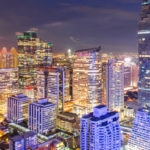Cities without walls
Human beings have always dreamed of magnificent cities. The imagined and mythical, like the so-called Lyonesse not far from the coast of Cornwall, or the Seven Cities of Cíbola located somewhere in the southwest of North America, or El Dorado, hidden in the pre-Colombian jungle. Surely behind these dreams looms the aspiration to find a model of harmonious coexistence. These would be cities attuned with the natural environment that surrounds them. With hanging gardens like those in ancient Babylonia or cloistered in a precious valley like Machu Pichhu, although these two examples actually did exist.

These tales point to a series of present-day, perfectly authentic values. Some of them, like healthcare, are aligned to the seventeen sustainable development goals, but many others are not within our framework of goals. And some ideas have not progressed at all throughout the course of history. Consequently, we have brought ourselves to 'The Uninhabitable Earth', as the journalist David Wallace-Wells points out.
Many of the legends about mythical cities are tied to the idea of wealth, health, or eternal youth. In those cities, life flourishes, whether because of the climate, where the city is, or its pure lushness. A mythical life can illustrate quite well where we would like to go.
Ancient cities — those that existed and those merely imaginary — were conceived with defensive mechanisms. As castles, walls, and naval forts attest. Protection was a fundamental part of the structure: these were closed cities.
Now, in the 21st century, cities should be conceived from a perspective of openness. The challenge is to ensure that this accessibility is ordered and flexible. More than half the world’s population lives in urban areas. And by 2050, this figure will climb to more than 68 percent, which is why thinking about open cities is so urgent. This also implies thinking about some of the reasons behind exploding urban populations: the neglect of rural areas, the prospect of natural disasters, low birth rates in the most developed countries, and economic contractions.
The intention of a new ethic, with renewed urban values, suitable to each city but with a common twist must be added to Saskia Sassen’s notions about the “global city” or Globalization and World Cities Research Network’s research projects.
An open city is a city that brings together all views. Its design should include a wide array of perspectives: from women, the elderly, children, ethnic minorities. And furthermore, an open city should be conceived with a focus on inclusion as the World Bank’s research division rightly points out.

It is expected that by 2050 more than 68% will live in urban areas.
The building of an open city is only possible with the collaboration of its inhabitants. A spirit that must begin with hospitality and solidarity, but that moves on — necessarily — to the payment of taxes, recycling, and respect for the law. And of course, the appreciation for its very culture and the innovations around it.
The perfect city — if there were one — would have to be designed with the diversity of its inhabitants in mind. Our cities have originated from a point of non-existent normality, because those who shaped the cities of the past have tended to be men with a perspective limited by their circumstances. Today our roads, houses, and offices must be conceived from every perspective, every angle.
We have devised closed structures without even realizing it: doors that are so heavy they can't be opened by the weakest of us, buttons that the shortest people cannot reach, seats in airplanes the largest of us cannot occupy. Our designs are obliviously discriminatory.
Thinking openly and inclusively not only brings us closer together, but empowers our sense of empathy, a crucial value for the cities of the future. Although far from presumed perfection, London, Paris, Cambridge, Munich, and Stockholm are examples of European cities promoting inclusive projects. And we must be aware of the role of inclusion in the economic recovery of cities, as demonstrated by a fantastic report released by the Urban Institute about North American cities like Augusta, Midland, and Vancouver.
This openness must also be in sync with the environment, using natural resources sustainably. The United Nations New Urban Agenda is an overdue — and very much needed — call to action addressing this issue.
With some difficulty and a lot of delay, we have begun to take steps towards more open and inclusive urban development. In Colombia, for example, national legislation has driven important changes in cities like Medellin and Bogotá. Other countries like Chile, South Africa, Brazil, and Indonesia have also made decisions in this regard. But there is still much to do.
Wheelchairs also travel our streets, crossed by crutches or orthopedic legs and explored by people who do not have the means to use public transportation. Increasingly, cities must evolve so they belong more to each and every inhabitant. When sidewalks are designed, thought should be given to the angles of the ramps, the height of the curbs, areas with gravel, and avoiding slippery sections.
This implies thinking about a lot more variables. The lamps that light the street should not be designed for people with perfect vision. But also, for those of us who do not see very well. Inclusive signage should do its job, showing everyone the way. Intelligent codes that can be read even if we have strained eyesight, macular degeneration, or are color blind. Cities without walls will have to be equipped digitally for its inhabitants and visitors. A new Google Maps project confirms this concern.
This inclusion must be multi-faceted: spatial, social, and economic. And also, cultural. Because a city can only open its doors with a knowledge of and esteem for its very identity.